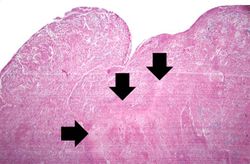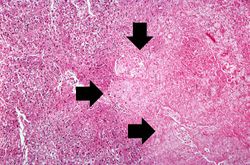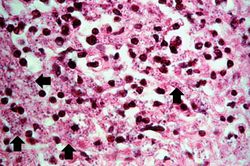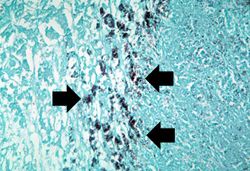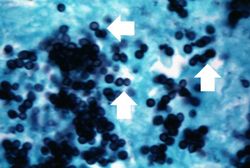Difference between revisions of "IPLab:Lab 10:Histoplasmosis"
| Line 17: | Line 17: | ||
File:IPLab10Histo7.jpg|This photomicrograph was taken under oil immersion to show the silver-stained Histoplasma organisms. Some of the organisms appear to be budding (arrows). | File:IPLab10Histo7.jpg|This photomicrograph was taken under oil immersion to show the silver-stained Histoplasma organisms. Some of the organisms appear to be budding (arrows). | ||
</gallery> | </gallery> | ||
| + | |||
| + | == Study Questions == | ||
| + | * <spoiler text="What is the usual route of infection with Histoplasma?">Histoplasma capsulatum infection is usually acquired by inhalation of dust particles from soil contaminated with bird or bat droppings. The droppings contain small spores (microconidia).</spoiler> | ||
| + | * <spoiler text="What types of infections does Histoplasma produce?">1) A self-limited primary pulmonary involvement which may result in coin lesions on chest x-ray; | ||
| + | |||
| + | 2) chronic, progressive, lung disease, which often localizes to the lung apices and causes cough, fever, and night sweats; | ||
| + | |||
| + | 3) localized lesions in extrapulmonary sites, including mediastinum, adrenals, liver, or meninges; and | ||
| + | |||
| + | 4) a widely disseminated involvement, particularly in immunosuppressed patients.</spoiler> | ||
| + | * <spoiler text=" "> </spoiler> | ||
| + | * <spoiler text=" "> </spoiler> | ||
{{IPLab 10}} | {{IPLab 10}} | ||
[[Category: IPLab:Lab 10]] | [[Category: IPLab:Lab 10]] | ||
Revision as of 16:03, 21 August 2013
Clinical Summary[edit]
For four months before death, this two-year-old black female infant ate poorly and lost weight. When hospitalized, she appeared chronically ill with signs of infection. An exploratory laparotomy showed the patient had enormously enlarged abdominal lymph nodes, the biopsy of which disclosed active histoplasmosis. Despite intensive therapy, the patient died three weeks after admission.
Autopsy Findings[edit]
Autopsy showed widespread enlargement of lymph nodes, ulcers of the intestines, and enlarged adrenal glands exhibiting multifocal granulomas.
Images[edit]
This is an even higher-power photomicrograph of an area of necrosis (arrows). There is loss of cellular detail within this area. There are inflammatory cells present; however, it is difficult to differentiate the inflammatory cells from the native lymphocytes of the adrenal gland--which is a lymph node.
Study Questions[edit]
| |||||
An infiltrate is an accumulation of cells in the lung parenchyma--this is a sign of pneumonia.

